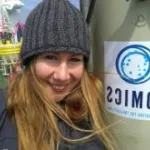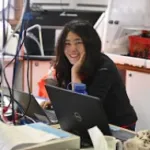Large quantities of CO2 (5–15Gt per year) are stored in the deep ocean via sinking organic matter, a process known as the ‘biological carbon pump’. The biological carbon pump is highly variable, driving variations in atmospheric pCO2 of up to 200ppm. Briefly, photosynthesis in the surface ocean produces ~100Gt of organic carbon per year, of which 5–15% sinks out of the surface to the deep ocean (it is ‘exported’). Most of the exported particulate organic carbon is processed by the water-column biota (microbes and zooplankton), who convert it into non-sinking forms of carbon, e.g. suspended particulate organic carbon and CO2 (‘remineralisation’). Until recently, attempts to quantitatively and mechanistically understand observed remineralisation by biological activity have failed.
Using field observations and modelling, our group at NOC pioneered important conceptual changes for the deep-ocean carbon cycle and constructed the first balanced carbon budget for the ‘twilight zone’ (50–1,000m). We demonstrated that synergetic processing of matter by both zooplankton and microbes is key to remineralisation, and therefore conceptually important for global biogeochemistry, oceanography, ecology, climate science and modelling.
Much of the exported particulate organic carbon is thought to sink out of the upper ocean in the form of large, fast-sinking particles accessible primarily to larger zooplankton. Yet, we found that microbes were responsible for 70–92% of the remineralisation in the twilight zone. We suggested that this redistribution of organic carbon occurred because zooplankton fragment and ingest fast-sinking particles, converting these to suspended and slowly sinking matter that can be readily processed by microbes. Our work highlighted that the transformation processes that occur within the twilight zone are fundamental to understanding the marine carbon cycle. We now need to know where, when and to what extent these transformation processes vary to accurately predict the response of the biological carbon pump to climate change.
To date we are unable to directly measure particle transformation processes in situ and are limited to laborious ex situ incubations that can only be carried out with much effort in few places. This knowledge gap drastically limits our ability to mechanistically understand and model the biological carbon pump. Our currently simple parameterisations of particle flux attenuation with depth are insufficient to accurately model ocean carbon storage and cannot recreate the observed interior nutrient fields.
This project will use cutting-edge in situ imaging and machine learning techniques to infer vertically-resolved particle transformation processes on large scales in order to mechanistically understand ocean carbon storage.


